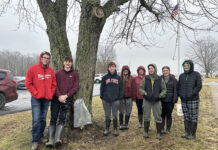SALEM, Ohio — A wet early spring will likely bring a moderate to above-moderate harmful algal bloom in Lake Erie this year, according to the National Oceanic and Atmospheric Administration’s annual HAB forecast.
The 2024 forecast is a 5 on the severity scale, with a potential range of 4.5-6. The severity index is a scale of 1-10. The forecast is on par with the 2023 bloom, which was a 5.3.
Scientists and researchers with Ohio State University’s Stone Laboratory and Ohio Sea Grant discussed the forecast during a live and virtual event on June 27.
The forecast
Harmful algal blooms are primarily caused by nutrient runoff from farmland, particularly phosphorus, so more rainfall typically means a higher potential for phosphorus runoff.
This past spring saw average to above-average rainfall in March and April, but a mild winter and a relatively dry May and June, said Laura Johnson, director of the National Center for Water Quality Research at Heidelberg University.
“As we came into April, there was a lot of capacity to absorb water,” she said, about the Maumee River, the highest source of phosphorus to Lake Erie’s western basin.
So, while discharge from the Maumee River into Lake Erie was average, the total particulate phosphorus loads were higher than expected, “probably because all that rain happened in April on uncovered ground,” she said.
“With rain on uncovered ground, you get more (phosphorus) particles when that happens,” Johnson said.
The Maumee River in northwestern Ohio contributes about 5% of the water flowing into Lake Erie’s western basin but nearly half of the total phosphorus load.
Updated models
The harmful algal bloom has been more severe than initially forecasted for the past three years, due to changing behavior in the blooms, said Richard Stumpf, oceanographer with NOAA’s National Centers for Coastal Ocean Science and lead scientist for the forecast.
“They are developing earlier over the past 10 years than previously, for reasons we do not yet understand,” he said. “An early start does not necessarily lead to a larger bloom, but it does mean the bloom lasts longer.”
To account for these changes, NOAA updated the forecast model algorithms now that two decades of data are available. For the last 10 years, the models used data from 2003–2012 to inform Lake Erie HAB forecasts. This summer, those models are using data from 2013 to the present, thereby improving the prediction of overall bloom severity.
The index predicts the size of the bloom, but not how toxic it will be. Larger blooms aren’t necessarily more toxic — while phosphorus runoff affects bloom size, nitrogen runoff influences the toxicity. Researchers are still working on tools to predict how toxic a bloom will be.
Right now, long-range forecasts show July is expected to be hot and relatively dry, meaning the forecast will likely stand the test of time. Heavy rains in July could bump up the severity of the bloom. NOAA will issue an updated forecast in late July based on observed nutrient loads in the western basin watershed.
In 2023, researchers predicted a mild bloom due to the abnormally dry spring and early summer. What was originally forecast as a 3 turned into a 5.3, or moderately severe, on the severity index. In 2021 and 2022, the bloom was also more severe than originally forecasted.
Last year, the bloom began in July and peaked in mid-August, persisting until early September when cool temperatures and elevated winds reduced its biomass. At its peak in 2023, the bloom covered 312 square miles and stayed closer to the U.S. coast, primarily from Monroe, Michigan to Port Clinton, Ohio.
Farming impact
The Ohio Farm Bureau noted that the heavier spring rainfalls occurred “well before nutrients were applied to farm fields for the 2024, growing season,” said Jordan Hoewischer, director of water quality research with Ohio Farm Bureau.
“It will be interesting to see how the bloom acts in the heart of summer, and if the bloom is above the range of past years, we have to really assess the data and learn more about where the nutrient load is coming from,” Hoewischer said.
Hoewischer said the timing of the rains, planting season and applications of fertilizer this spring should emphasize the importance of the use of cover crops, one of the programs farmers are utilizing through H2Ohio, to keep nutrients and soil in place throughout the year. There were 11,300 acres of cover crops funded through the H2Ohio in the 2023 fiscal year.
The H2Ohio program, created in 2019 by Gov. Mike DeWine, has been pumping more than $60 million a year into the Ohio Department of Agriculture to decrease agricultural phosphorus runoff through implementing best management practices.
The program was initially open to only 14 counties in northwestern Ohio near Lake Erie, but it was expanded this year to all 88 counties.











